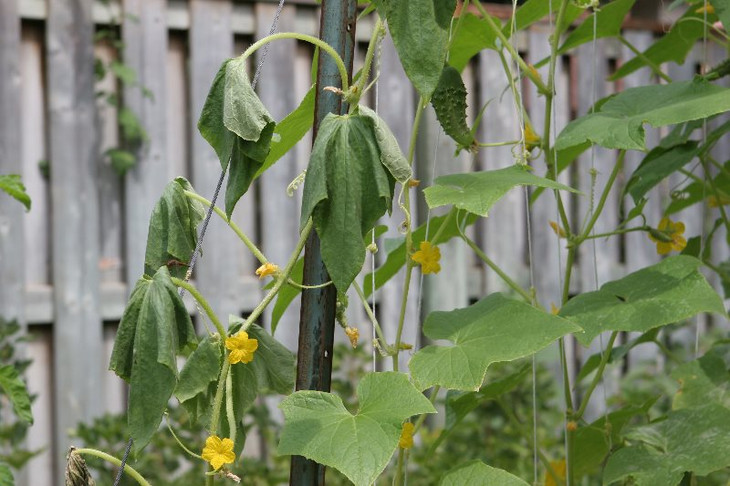 Cultivation of cucumbers is an interesting and difficult task. After all, vegetables are demanding on temperature conditions and soil composition. Often the trouble for amateur growers is the sharp withering of the leaves of the bushes.
Cultivation of cucumbers is an interesting and difficult task. After all, vegetables are demanding on temperature conditions and soil composition. Often the trouble for amateur growers is the sharp withering of the leaves of the bushes.
Loss of turgor is a common problem, and many factors influence its causes.
Content
Causes of Leaf Withering
There are several reasons for the appearance of wilting foliage. Cucumbers are a sensitive crop and react painfully to both lowering and increasing temperature conditions. In addition, the excess or lack of minerals, the attack of pathogens or parasitic insects affects the loss of turgor.
Insufficient or excessive watering
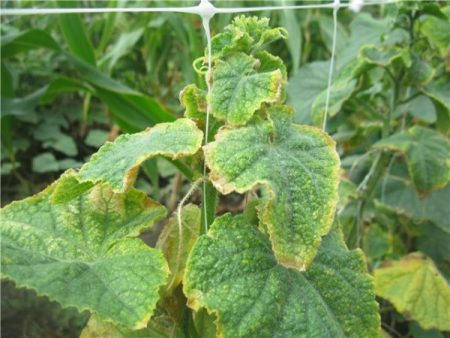 The reasons that should first be paid attention to when the plant turgor is lost are a lack or excess of moisture.
The reasons that should first be paid attention to when the plant turgor is lost are a lack or excess of moisture.
- Inadequate watering is the first reason for withering the leaves of cucumbers. After all, this vegetable crop is very demanding on moisture. With insufficient moisture in the soil under the cucumbers, the vegetative mass loses turgor within a few hours. In case of the first signs of drying out of the soil, it must be immediately watered. If this action is not performed, the wilted leaves will dry out, fall off, and the plant will die in five to six days.
- Excess moisture in the soil does not allow cucumbers to receive oxygen. The roots of plants that do not “breathe” fully do not send it to the leaves. Cucumbers gradually fade, lose turgor, cease to bear fruit and soon die due to a lack of oxygen.
Lack or excess of nitrogen
Cucumber is a very demanding crop for substances such as nitrogen and potassium. The lack of elements in the soil will lead to poor plant growth and withering of its foliage. However, an excess of fertilizers also negatively affects the crop.
- For the active growth of the vegetative mass, cucumbers need nitrogen. With a lack of soil, the plant is depleted, and the foliage begins to gradually fade. Culture loses immunity and does not set fruit.
- With an excess of nitrogen in the soil, the foliage of cucumbers in the first three days acquires a rich green hue. Then the lower and middle leaves begin to curl and fade. After 5-6 days, the foliage is painted in a gray-yellow tone, the fruits are smaller, the plants are sick and die.
It is possible to increase the nitrogen content in the soil by spraying calcium cucumbers with nitrate once every two weeks. In order not to cause burns to the foliage during processing, spray the plants only in the evening hours!
Sun rays
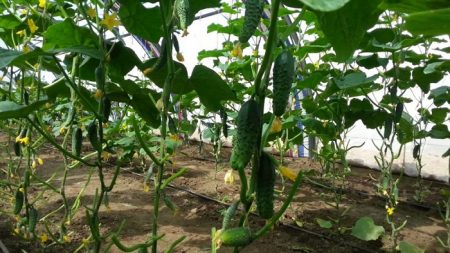 The homeland of cucumber is considered to be the subtropical regions of China and India. There, this culture still grows in the wild under the canopy of trees, encircles them and is not under the scorching sun.
The homeland of cucumber is considered to be the subtropical regions of China and India. There, this culture still grows in the wild under the canopy of trees, encircles them and is not under the scorching sun.
Often plants get sick due to prolonged exposure to the sun. The foliage withers under scorching influence, the plant loses turgor, the flowers do not tie fruit.
Pathogens and parasitic insects
Often the reason for the poor health of cucumbers is an attack by parasitic insects that suck out the milky juice of the plant, as well as the defeat of pathogenic fungi.When an attack of pests, the lower part of the bushes begins to wither, losing the turgor completely for several days, and then dies.
- Pathogenic microbes that can cause decay of the foliage of cucumbers: peronosporosis, fusariosis, white, root rot. In case of damage by pathogens, the plant begins a gradual decrease in turgor, the fruits are not tied. Without initiating timely control measures, culture perishes.
- Parasitic insects that can cause leaf wilting: gourds, thrips, spider mites and apple mites. In case of untimely detection of the pest and control measures, the plants sharply lose turgor, get sick, drop leaves, do not set fruits, and die 8-10 days after the onset of action.
Thickened landings
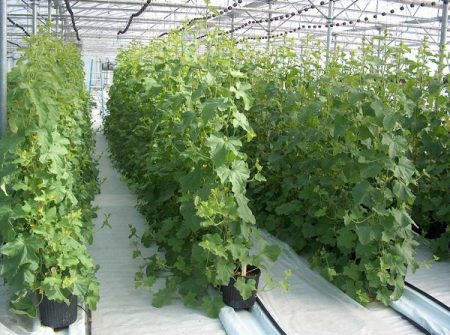 The reason for the loss of turgor is often the planting of cucumbers too close to each other. With a dense planting, plants do not receive enough nutrition from the soil. The root system of cucumbers weakens, feeds a small amount of nutrients to the vegetative mass. Due to this process, plants weaken, 80% fewer fruits are tied, foliage withers, and the crop can not be expected.
The reason for the loss of turgor is often the planting of cucumbers too close to each other. With a dense planting, plants do not receive enough nutrition from the soil. The root system of cucumbers weakens, feeds a small amount of nutrients to the vegetative mass. Due to this process, plants weaken, 80% fewer fruits are tied, foliage withers, and the crop can not be expected.
Why do cucumbers wilt in a greenhouse?
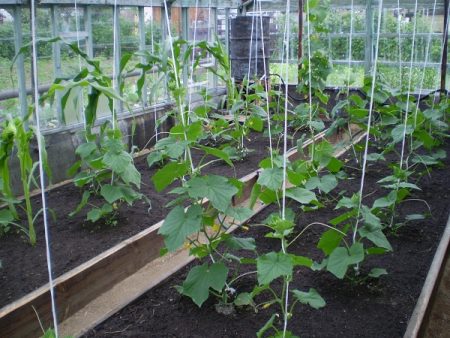 Most varieties and hybrids of cucumbers intended for cultivation in closed ground are characterized by increased resistance to diseases and negative natural factors. However, there are reasons why even resistant varieties can lose turgor density when grown in greenhouses. If the foliage on the cucumbers fades, it is necessary to find out the source of the problem and quickly begin to eliminate it.
Most varieties and hybrids of cucumbers intended for cultivation in closed ground are characterized by increased resistance to diseases and negative natural factors. However, there are reasons why even resistant varieties can lose turgor density when grown in greenhouses. If the foliage on the cucumbers fades, it is necessary to find out the source of the problem and quickly begin to eliminate it.
- Violation of the light regime. Daylight hours for a cucumber are 16-18 hours. With a deviation from the norm, the plant begins to hurt and lose turgor.
- Violation of night temperature conditions. Cucumbers - a culture that requires when growing temperature at least 18 degrees at night. If the regime is not respected, the plant slows down in growth, loses immunity, discards flowers, and foliage fades.
- Excess or lack of minerals. With an excess of potassium greenhouses in the soil, mosaic spots appear on the foliage, which lead to withering and drying. In cases of supersaturation of soil with copper, inter-vein chlorosis occurs on the lower leaves of cucumbers, which leads to the loss of turgor of the entire plant. With a lack of elements, the foliage turns pale, and the shoots become weak and lethargic.
- Lack or excess of watering. With insufficient watering of the soil in greenhouses, the natural reaction of cucumbers will be wilting of foliage. However, in case of soil waterlogging, the root system does not receive a sufficient amount of oxygen and does not supply it to lashes and leaves. Therefore, plants begin to dramatically lose turgor.
- Overheat. Despite the fact that cucumbers are a culture originating from the tropics, they do not tolerate temperatures above +37 degrees during the day. Heated air in the greenhouse above this norm will contribute to the loss of turgor and plant immunity.
- Pathogens and parasites. Aphids and spider mites pose a great danger to cucumbers cultivated in greenhouses. These parasites suck out the milky sap of plants, which leads to wilting of leaves and complete death of bushes. Pathogen mushrooms also affect the health of cucumbers in greenhouses. When plants are affected by root rot, bacteriosis, peronosporosis, fusarium, it will not be possible to avoid leaf wilting.
To prevent the defeat of cucumbers in greenhouses by pathogen fungi, it is necessary to constantly loosen the soil under the bushes, to ensure adequate ventilation. If the plants nevertheless become infected and begin to lose turgor, treat cucumbers from spore-parasites with the preparations: Quadris, Topaz, Ridomil Gold.
The fight against leaf wilting folk remedies
Withering of foliage of cucumbers leads to significant crop losses. Folk methods of struggle will help gardeners prevent trouble, while receiving environmentally friendly vegetables.
Fighting rot and verticillosis
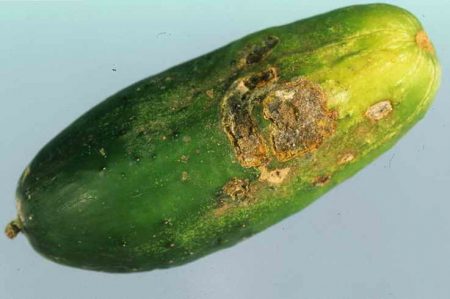 Each summer resident will always find activated carbon, wood ash. These components inhibit the development of rot and fungus-Verticillium, which cause the decay of cucumber foliage.
Each summer resident will always find activated carbon, wood ash. These components inhibit the development of rot and fungus-Verticillium, which cause the decay of cucumber foliage.
Cooking
- Grind 5 tablets of activated carbon.
- Add 1 cup of wood ash, 3 tablespoons of chalk, 50 ml of water to the powder.
- Stir the components until a mushy mass.
- Apply gruel on the base of the stems of cucumbers.
- Disinfectants will prevent infection in the plant, inhibit rotting of the root system, which causes leaf decay.
Fighting gourds and arachnids
Tincture of onion husks and bitter peppers will serve as a repellent for sucking pests that cause decay of the leaves of cucumbers.
Cooking
- 300 g of onion husks pour 5 l of hot water.
- Add 1 crushed red hot pepper, 2 tablespoons of sugar.
- The mixture is insisted for three days in a warm place.
- Strain the infusion, spray the plants 1 time in 3 days.
- The burning concentrate of the infusion will scare away the pest, and cucumbers will receive additional nutrition during processing with a solution of onion husks.
Powdery Mildew
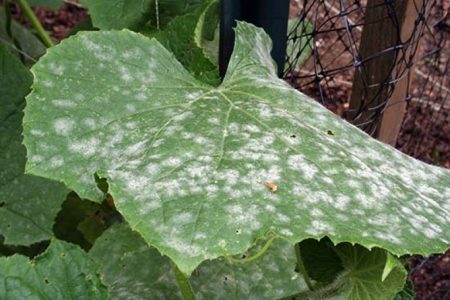 Powdery mildew, which causes leaf wilting, helps to cope with mullein infusion. During fermentation, manure emits gas, which neutralizes harmful spores.
Powdery mildew, which causes leaf wilting, helps to cope with mullein infusion. During fermentation, manure emits gas, which neutralizes harmful spores.
Cooking
- 4 kg of fresh cow manure pour 5 liters of warm water.
- The solution is infused in a warm place for three days.
- Dilute the finished concentrate with water 1: 1, spray the foliage of cucumbers every 2-3 days.
- Mullein infusion, used in the processing of cucumbers, will not only neutralize harmful spores, but will also saturate the plants with nitrogen.
Prevention
Preventive measures against the appearance of pests and pathogens that cause foliage to wither are:
- autumn soil treatment with copper sulfate or Bordeaux fluid;
- dressing of cucumber seeds with Previkur or Fitosporin preparations;
- when growing cucumbers in a greenhouse, create sufficient ventilation for the plants;
- timely loosening of the soil and getting rid of weeds in the area under the cucumbers.
In order to get a decent crop of cucumbers, each gardener should get acquainted with the possible problems in its cultivation and ways to eliminate them.




 Armenian cucumber with melon flavor: description and characteristics, reviews
Armenian cucumber with melon flavor: description and characteristics, reviews Do-it-yourself vertical beds for cucumbers: schemes, photos
Do-it-yourself vertical beds for cucumbers: schemes, photos Hollow cucumbers: reasons for the appearance of hollow, what to do
Hollow cucumbers: reasons for the appearance of hollow, what to do Which manure is best for cucumbers: application, how to breed
Which manure is best for cucumbers: application, how to breed